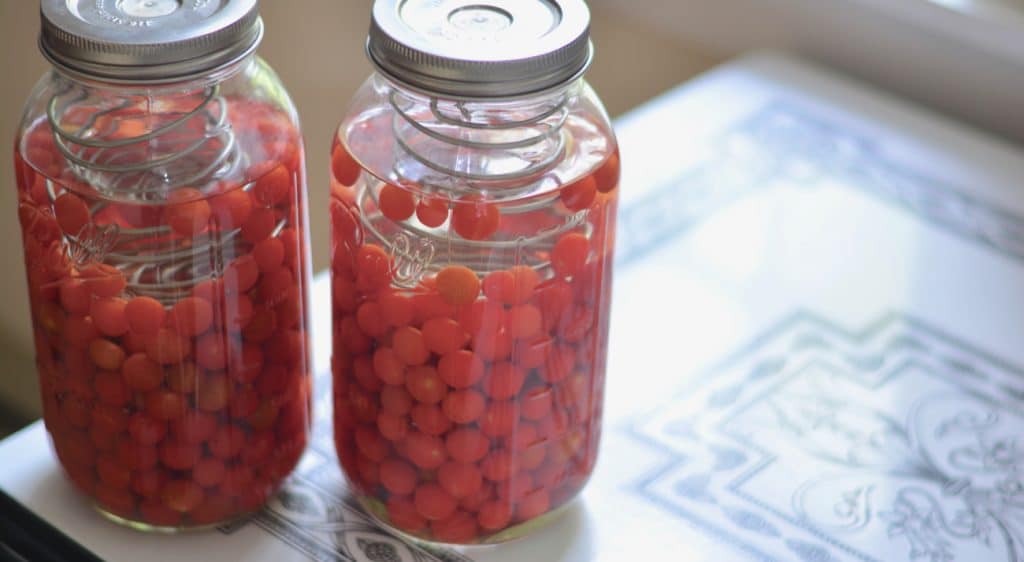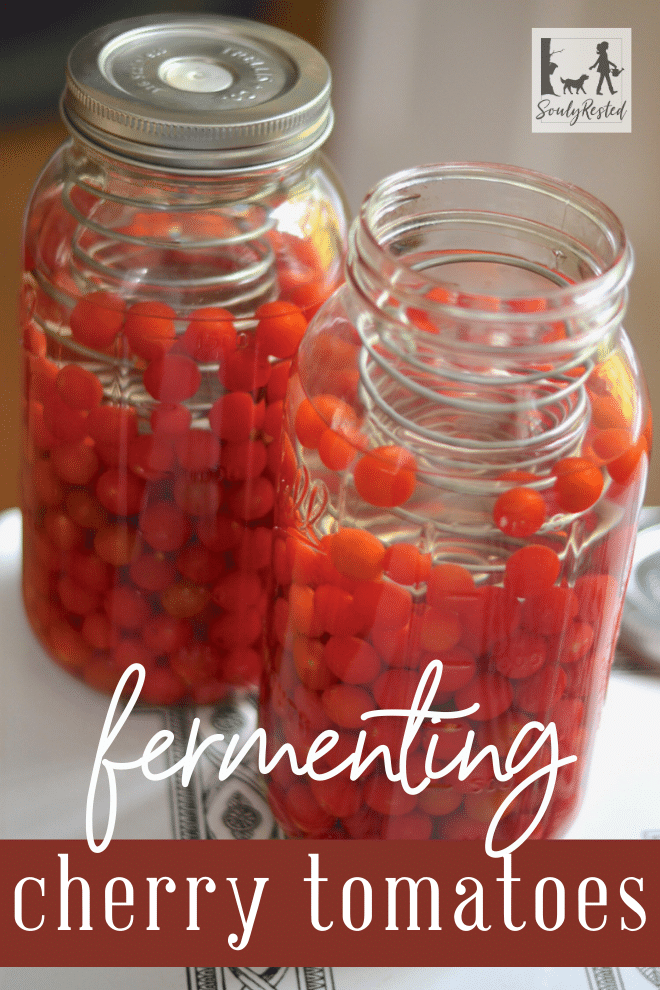Last Updated on September 16, 2023 by Michelle
I showed my fermented cherry tomatoes on my instagram stories last week and within hours so many people had asked how to ferment cherry tomatoes and what I do with them! Apparently this isn’t something many of you have thought of doing.
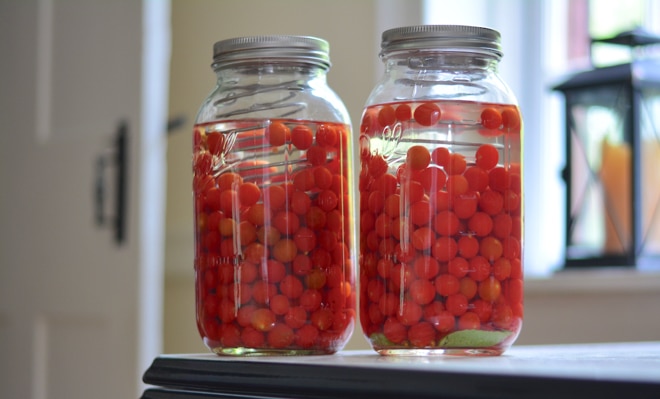
I don’t like all fermented veggies. In fact, I won’t even go near sauerkraut. But I’m here to tell you that fermented cherry tomatoes are awesome.
Find out all the other foods I keep stocked in my pantry by downloading this FREE 8-page checklist that will get you started towards a more nutritious family table.
How to Ferment Cherry Tomatoes
Keep reading for every detail, or if you’re more of a visual learner, I walk you through the whole process in this video as well:
Some favorite fermented foods?
For some reason, I think many people are like I used to be when they hear the word “fermented.” They think of sour tasting cabbage. But the truth is there are so many options for fermented foods beyond sauerkraut and kimchi.
- Yogurt is a fermented diary product made with bacterial cultures. Homemade maple yogurt is one of my favorite snacks, ever.
- Sourdough bread is made with a fermented flour starter. And we make at least one or two loaves of sourdough bread every week around here. Would you like the full scoop on my unique recipe? Right here I explain exactly how I make sourdough bread with zero wasted discard.
- Kombucha is a delicious, carbonated, fermented tea that you can make at home. More about DIY Kombucha right here.


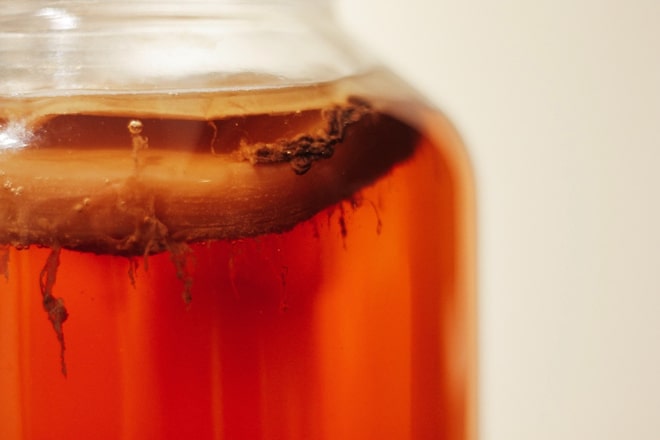
Why eat fermented foods?
We do so many things in our modern culture–from not getting enough exercise and time outdoors to being too stressed–that destroys our gut health. Enjoying fermented foods and drinks helps restore the good gut flora that we need.
Is it okay to eat fermented tomatoes?
It’s more than “okay,” eating fermented cherry tomatoes (or any fermented foods) is extra good for your gut health. We chat all about this, in detail, on this episode (S5 E20) of the Simple Doesn’t Mean Easy podcast:
What do fermented cherry tomatoes taste like?
Fermented cherry tomatoes taste like salty, slightly tangy tomatoes. They’re delicious on salads, sandwiches, and in scrambled eggs, and topping homemade pizza.
Folks get tripped up on this often. Let me just tell you right now, all fermented foods do NOT taste like sauerkraut. In fact, my favorite veggies to ferment (tomatoes and peppers) simply taste like saltier, slightly tangy, versions of themselves.
What’s the best food to ferment?
I love making sourdough bread. I give you my complete recipe and the full scoop on how i make fermented sourdough bread every week without one ounce of wasted discard right here: My Sourdough Recipe Without Discard.
But even more than bread, my favorite thing I’m always fermenting in my kitchen isn’t even “food”… it’s my favorite drink. Kombucha. This recipe right here is my absolute favorite kombucha. And right here I give you the full scoop into making kombucha yourself.
Do you need fancy equipment to ferment cherry tomatoes?
You can ferment any veggie in any container you’d like to try, as long as you have some sort of weight to keep the veggie in your salt brine and some sort of a loose lid, to keep the bugs and critters out.
But I find the easiest way to ferment any veggie is with this fermenting springs kit. Granted, the smallest cherry tomatoes can creep up around the spring, so I should probably lay a cabbage leaf or some other such thing over top of my tomatoes before inserting the spring. Maybe I’ll think of this next time… But even so, most of the tomatoes stay submerged with this set up.
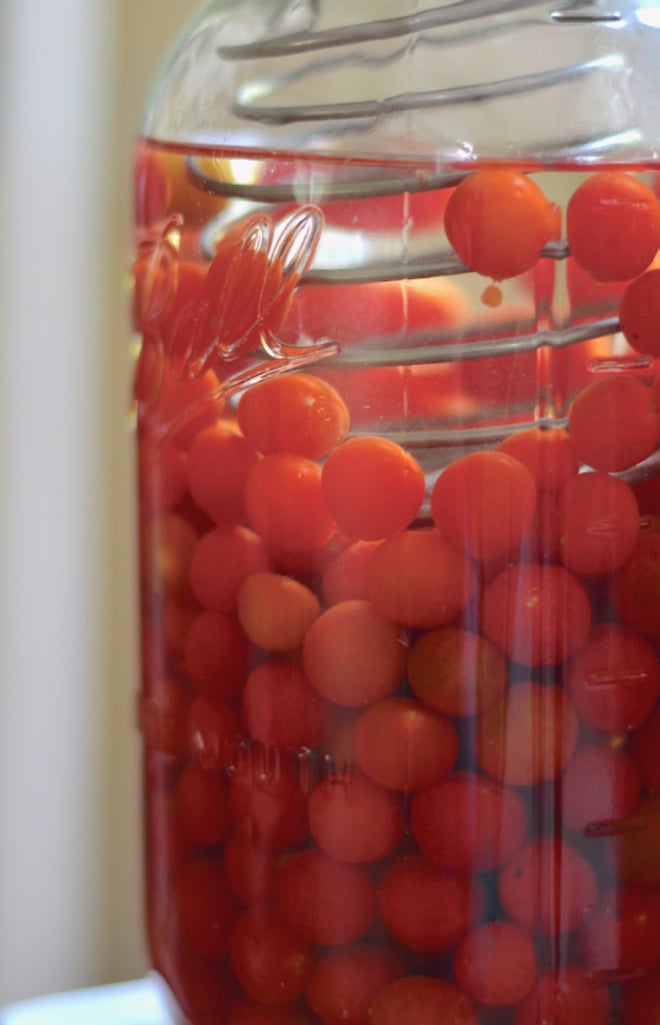
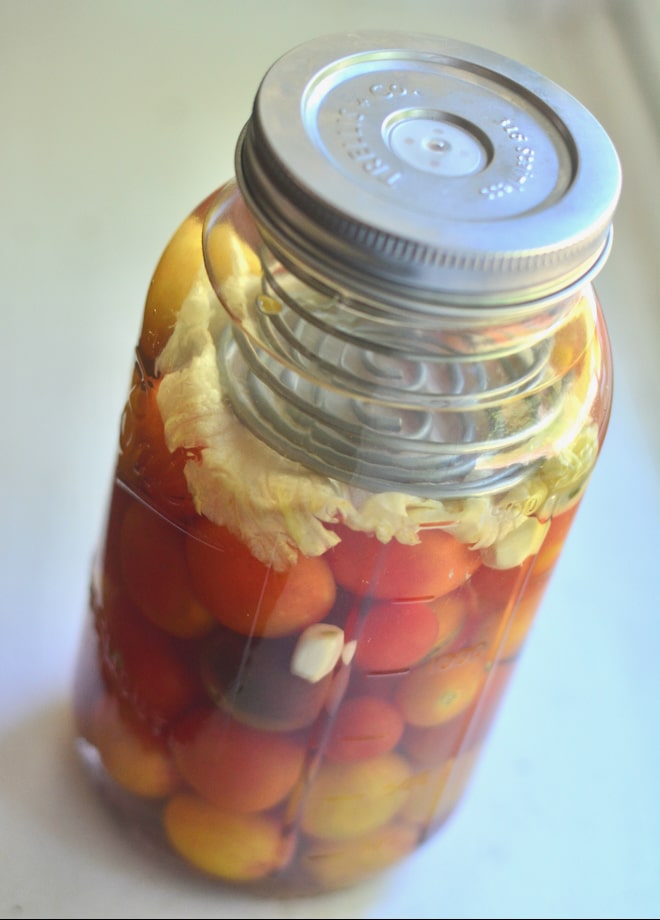
Fermented Cherry Tomatoes
What you’ll need to ferment cherry tomatoes
- Jar of washed cherry tomatoes (any size is fine)
- 2 – 3 fresh basil leaves
- 1 – 2 garlic cloves
- 1 tsp black peppercorns (optional)
- 1 head fresh dill (optional)
- Prepared brine (see below)
- Some way to keep the tomatoes submerged and the bugs out… I love my springs and special lid
Note: feel free to play around with whatever seasonings you’d like to try. The only thing you can’t alter is your brine. You want to be sure you have the right amount of salt and the right kind of salt! But often I will just toss in a few basil leaves and garlic cloves for seasoning.
Brine for fermented cherry tomatoes
- 2 cups of filtered water
- 1 ½ tablespoons unrefined salt (this is the best… use code SOULYRESTED to try it yourself and enjoy a nice savings)
- Double or triple this, as needed
Directions for fermenting cherry tomatoes
- Dissolve salt in water to make brine.
- Place your flavorings into a clean mason jar. I use whatever I have on hand, which is usually fresh basil and dill, garlic, and peppercorns. But I’ve made them with just garlic as well, or any combination of the above. It’s always good.
- Place your cherry tomatoes on top of your seasonings. I pierce each one with a toothpick, to allow the brine to easily infuse the kinda tough tomato skins.
- Pour your brine over the tomatoes until they’re completely covered, and top with a fermenting spring. If you don’t have a spring, feel free to be creative with any thing you can place on top of the tomatoes to keep them under the salt water.
- Cover the jar with the fermenting lid, which has built in air holes that are lightly covered to keep out the unwanted pests. Or use a well-secured piece of fabric over the jar.
- Place your jar in a larger bowl, to hold any brine that may bubble out of your jar, and set the jar in a little used (preferably kinda dark) area of your kitchen.
- Taste around day 5-7. If it tastes great, place a regular lid on the jar and move it to the fridge. I like to remove the added flavorings before storing them, to keep the garlic or dill, or whatever I’ve used, from getting too overpowering in the months ahead. If you’d like to let it ferment longer, go for it and just taste it every so often until it’s the way you want it.
- Store your fermented cherry tomatoes, in their brine, in the fridge for many long months. I’ve kept them up to a year, in the back corner of my fridge, and enjoyed them just as much at the end as at the beginning.

Side note: When I made this batch of tomatoes, I had a large colander full of tomatoes I had just harvested from our garden. It was about 11 or 12 cups of cherry tomatoes. I didn’t want to unnecessarily squish them, so I divided them among two 1/2 gallon jars, but I could have filled up one jar and left it at that if I wanted.
Other side note: If you have more veggies in your near future that you might want to ferment, feel free to make things super easy for yourself and make extra brine. Just store it in the fridge until you’re ready to use it. The wonderful minerals will settle out to the bottom (in the second picture below), but that’s totally fine. Just give it a stir, and it’s good to use.


Other recipes for fermenting cherry tomatoes
Fermented cherry tomatoes are delicious y’all. And so forgiving. Seriously there are so many ways you could try out different flavors in your brine. Consider adding any of these options:
- any combination of add-ins that you like of what I list above
- feel free to use or 1/2 tsp dill seed in place of fresh dill
- feel free to use 1/2 tsp of dried basil in place of fresh leaves
- mustard seeds
- peppers that you want to ferment with the tomatoes
- really any other fermenting veggie would be fine (and pretty)
You can also use any non-iodized salt, but I never use any salt other than Redmond’s Real Salt for fermenting. But I do change up which Redmonds salt I use, if I don’t have the fine powder salt in my pantry. It is my preference though, because it dissolves so nicely.
If you need to stock up on Redmonds, be sure to use my special coupon and enjoy 15% off your entire purchase (cause um, who doesn’t want that?). Just order at this link and use code SOULYRESTED.
How long can you keep fermented cherry tomatoes?
You can store your tomatoes, in their same jar and brine that you fermented them in, in the fridge for months. Dare I say many months, and they’re still delicious.
The first picture below was when the tomatoes had been stored in my fridge for 3-4 weeks. The second picture was 6 months later. A little flatter, but just as tasty.
Also, these were Matts Cherry Tomatoes, not the ideal choice for fermenting, just because they are softer than most.
What varieties of cherry tomatoes are good for fermenting?
I have found over the years that my favorite varieties for fermenting are:
Sunrise bumblebee
Bonus, these three together make for a gorgeous jar of tomatoes. (This is the combo I used in this youtube video: How to Ferment Cherry Tomatoes.)
Other varieties I’ve tried but found to get mushier over time:
matts (pictured below)

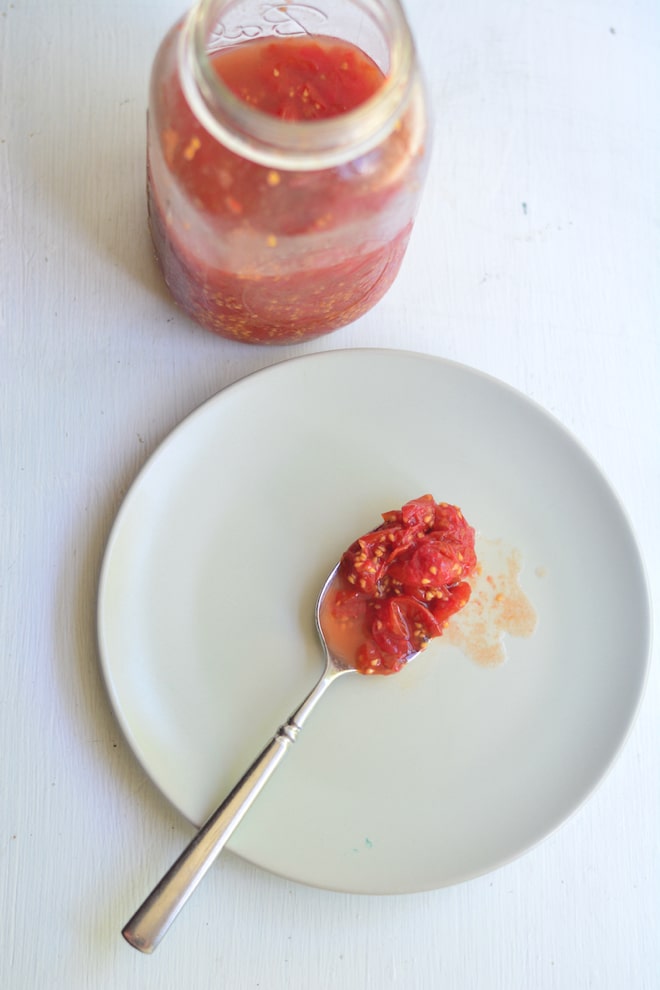
How do you use fermented cherry tomatoes?
You can use fermented cherry tomatoes in any meal you would use tomatoes in.
If I’m adding them to things like soup or alfredo sauce (served over pasta, with a slice of bacon on the side… mmmmmm….), I’ll add them in right at the end, so the heat in the pan or skillet doesn’t destroy any of their wonderful fermented properties.
All the ways I use fermented cherry tomatoes?
- On a tossed salad with this dressing
- Mixed in in the last minute to scrambled eggs
- In a sandwich, with sprouts and meat
- As part of antipasto
- With hummus
- Mixed into guacamole
- In soup, especially squash soup
- In alfredo sauce, over pasta
However you use these slightly salty tomatoes with a nice little kick, I’m pretty sure you’ll love them. These and fermented peppers are two of my favorite fermented veggies.
What is that white stuff in my ferment?
If you are new to fermenting veggies, I should tell you about the yeast. It’s pretty cool once you know what it is, but it can be pretty shocking if you don’t.
You see, kahm yeast starts to form over fermenting veggies when the lactic acid builds up (which is great news for your gut health). You might not have this happen to your jar of tomatoes, but you are definitely more likely to see a thin layer of kahm yeast with sweeter veggies, like beets, carrots, sweet peppers, and tomatoes.
If you do have yeast form, it may be much less dramatic than mine, which looked kinda like the surface of the moon, huh? But it’s all good. Just skim it off and you’re good to go. While kahm yeast won’t hurt you to eat it, it may not taste so good, so I feed the veggies on top of the brine, that have the yeast on them, to my chickens.
Yeah, my chickens love me. I grow herbs just for them and I feed them my yeasty tomatoes. I’m kinda a rock star in their little poultry eyes.

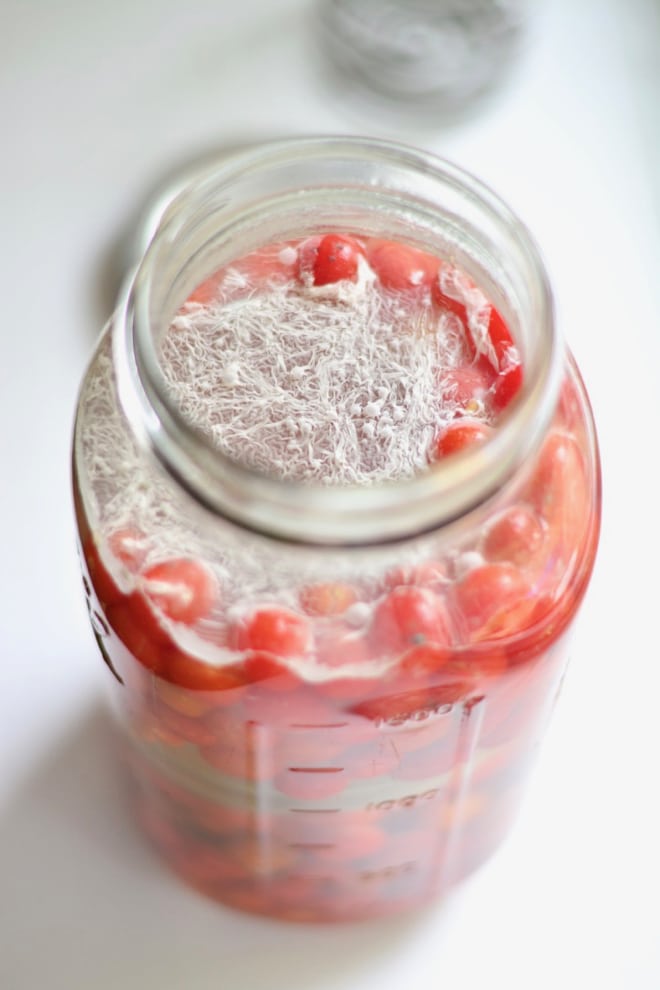
Other Gut-Healthy (aka Fermenting) Articles You’ll Love:
My Hesitant Experiment fermenting cauliflower
Sourdough, gut-friendly pizza crust (yep, you read that right)
DIY Kombucha–What’s it really cost?
4 Foods to Eat for Gut Health (and yes, fermented cherry tomatoes is one) podcast episode
He gives food to every creature. His love endures forever. Psalm 136:25
Pin this for later!
Click on the image below to pin this post.
Find out why SoulyRested was considered to be one of the Top 20 Must-Read Homesteading Blogs of 2018 and then one of the Top Homesteading Blogs of 2019 as well.
Glance at my Resource Page if you’d like to get a glimpse of all the supplies I use and recommend for everything from gardening, to homeschooling, to chicken care, to nature journaling, to maple syrup making.
I’d love to connect!
To find me in some other neck of the woods, just click any (or every!) icon below:
And please join in on my resource library. I’m often adding sweet bonuses.


